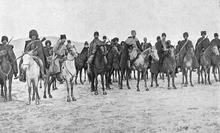Khetcho: Difference between revisions
Extended confirmed users 10,579 edits m Disambiguated: Mush → Muş Province |
Rescuing 1 sources and tagging 0 as dead. #IABot (v1.6.1) |
||
| Line 35: | Line 35: | ||
==Early life== |
==Early life== |
||
Khetcho was born Khachadur Amirian in 1872 in [[Nakhichevansky Uyezd|Nakhichevan]] which was then part of the [[Russian Empire]].<ref name=ararat>{{cite journal|title=Khecho|journal=Ararat|page=46|url=https://books.google.com/books?id=XrAwAQAAMAAJ|publisher=Armenian United Association|location=London}}</ref> His father was a local priest.<ref name=ararat1>{{cite journal|title=A Man of Action and a Hero|journal=Ararat|date=Nov 1917|volume=5|issue=53|pages=210–2}}</ref> He studied in [[Shushi]] at the local Diocese School.<ref name=hrach>{{cite book|last1=Tasnapetean|first1=Hrach|title=History of the Armenian Revolutionary Federation, Dashnaktsutiun, 1890-1924|date=1990|publisher=Oemme Edizioni|page=189|url=http://www.historyoftruth.com/ebook/HistoryOfTheARF.pdf}}</ref> Khetcho goes on to become a trainer of Armenian revolutionary fighters who were mainly stationed in the [[Caucasus]].<ref name=armenian>{{cite book|editor1-last=Manchikean|editor1-first=Hakob|title=Houshamatyan of the Armenian Revolutionary Federation: album-atlas|date=2006|publisher=Western United States Central Committee of the Armenian Revolutionary Federation|location=Los Angeles|isbn=0963527843|page=56|url=https://books.google.com/books/about/Houshamatyan_of_the_Armenian_Revolutiona.html?id=_kROYgEACAAJ|language=Armenian}}</ref> |
Khetcho was born Khachadur Amirian in 1872 in [[Nakhichevansky Uyezd|Nakhichevan]] which was then part of the [[Russian Empire]].<ref name=ararat>{{cite journal|title=Khecho|journal=Ararat|page=46|url=https://books.google.com/books?id=XrAwAQAAMAAJ|publisher=Armenian United Association|location=London}}</ref> His father was a local priest.<ref name=ararat1>{{cite journal|title=A Man of Action and a Hero|journal=Ararat|date=Nov 1917|volume=5|issue=53|pages=210–2}}</ref> He studied in [[Shushi]] at the local Diocese School.<ref name=hrach>{{cite book|last1=Tasnapetean|first1=Hrach|title=History of the Armenian Revolutionary Federation, Dashnaktsutiun, 1890-1924|date=1990|publisher=Oemme Edizioni|page=189|url=http://www.historyoftruth.com/ebook/HistoryOfTheARF.pdf|deadurl=yes|archiveurl=https://web.archive.org/web/20130903141813/http://www.historyoftruth.com/ebook/HistoryOfTheARF.pdf|archivedate=2013-09-03|df=}}</ref> Khetcho goes on to become a trainer of Armenian revolutionary fighters who were mainly stationed in the [[Caucasus]].<ref name=armenian>{{cite book|editor1-last=Manchikean|editor1-first=Hakob|title=Houshamatyan of the Armenian Revolutionary Federation: album-atlas|date=2006|publisher=Western United States Central Committee of the Armenian Revolutionary Federation|location=Los Angeles|isbn=0963527843|page=56|url=https://books.google.com/books/about/Houshamatyan_of_the_Armenian_Revolutiona.html?id=_kROYgEACAAJ|language=Armenian}}</ref> |
||
==Khanasor Expedition== |
==Khanasor Expedition== |
||
Revision as of 21:01, 9 December 2017
Khetcho | |
|---|---|
|
Khetcho (
Early life
Khetcho was born Khachadur Amirian in 1872 in
Khanasor Expedition
In 1896, during the aftermath of the Defense of Van, the Mazrik tribe had ambushed many of the Armenian defenders of Van as they were retreating into Persia. The Armenian Revolutionary Federation decided to retaliate, resulting in the Khanasor Expedition. Khetcho departed from Persia and participated in the expedition which became his first armed combat mission.[4][5] During the mission, Khetcho met Yeprem Khan, another Armenian Revolutionary who Khetcho eventually collaborated with during the Iranian Constitutional Revolution.[5]
Armeno-Tatar clashes
Thereafter, during the
Iranian Constitutional Revolution
During the
World War I


In the

Prior to the start of World War I, Khetcho participated in the Armenian Revolutionary Federation Council meeting in Berlin.[3] Khetcho was then tasked to acquire armaments in order to support self-defense efforts.[11] At the start of the war, he was one of the five Armenian legions formed to enter Ottoman territory forming the Armenian volunteer units under Russian command.[12] During the Van Resistance, Khetcho's unit was among the first to enter and liberate it on May 5, 1915.[13] This was followed by the Russian armies occupation of the city a few days later.[13]
Death
After Van was liberated, Khetcho and his squadron were assigned to assist self-defense efforts in
References
- ^ a b c "Khecho". Ararat. London: Armenian United Association: 46.
- ^ a b c d e "A Man of Action and a Hero". Ararat. 5 (53): 210–2. Nov 1917.
- ^ a b c d e Tasnapetean, Hrach (1990). History of the Armenian Revolutionary Federation, Dashnaktsutiun, 1890-1924 (PDF). Oemme Edizioni. p. 189. Archived from the original (PDF) on 2013-09-03.
{{cite book}}: Unknown parameter|deadurl=ignored (|url-status=suggested) (help) - ^ ISBN 0963527843.
- ^ ISBN 0813338174.
- ^ a b Ayvazyan, H. M. (2005). Ov ov ē hayer: kensagrakan hanragitaran. Haykakan hanragitaran hratarakchʻutʻyun.
- ISBN 1940573092.
- ^ Vahagn Avedian. "History of Armenia". Armenica.org. Armenica. p. 276.
- ISBN 9781441194787.
- ^ ISBN 9780691153339.
- ISBN 1412848342.
- ISBN 095114362X.
- ^ a b Karapetian, Jack (April 1986). "The Heroic Stance at Van" (PDF). Hye Sharzhoom. 7 (3): 5.
- ^ Walker, Christopher J. "The End of Armenian Taron and Baghesh, 1914–1916" in Armenian Baghesh/Bitlis and Taron/Mush, pp. 191–206.
- ^ ISBN 1848855613.
External links
 Media related to Khetcho at Wikimedia Commons
Media related to Khetcho at Wikimedia Commons
